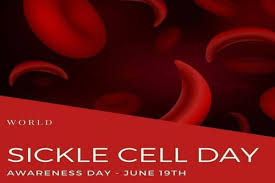Today is World Sickle Cell Day—a day designed to spread awareness and understanding of sickle cell disease–an often painful inherited blood disorder.
The Sickle Cell Disease Association of America (SCDAA) is marking the 10th year of this recognition. There is no cure for sickle cell disease right now, although some patients have had success with various treatments including hydroxyurea treatment and bone marrow treatment.
According to SCDAA, complications from sickle cell disease (SCD) happen when a normal blood flow is reduced or prevented from flowing normally throughout the body. With SCD, some normally round red blood cells become crescent shaped (sickle shaped) and because of that change, can no longer flow through small blood vessels. These misshapen cells can actually cause a blockage, thereby reducing a normal blood flow that tissues need to stay healthy and to keep the body functioning properly. A common result is that reduced blood flow damages tissues and can lead to debilitating pain.
Blood cells with sickle cells don’t live as long in the body (about 16 days vs. 120 days for normal cells according to the SCDAA), so that rapid turnover can lead to the myriad complications that come with a sickle cell diagnosis including anemia and jaundice. Because SCD affects nearly every organ in the body, systemic complications can involve major systems including the lungs and kidneys. And the damage can also leave the body less able to fight off and control infections.
Current treatments are often a reaction to the complications, although some, like a preventative antibiotic and vaccinations in children, can help prevent complications from beginning. Patients may find various combinations of blood transfusions, pain management, antibiotics, breathing treatments, proper vaccinations, and other medications.
As with other chronic conditions, people with SCD have to take extra care with their own health. Because people are born with sickle cell disease, the disorder is a lifelong condition and can be especially challenging for children to cope with. Generally, a hematologist will manage the condition and any treatments. According to the Centers for Disease Control and Prevention, staying well-hydrated is especially important as is good nutrition and rest. Anyone with sickle cell disease can stay active to help overall health, but just be especially aware of fatigue and fluctuations in body temperature—moderation is the best approach.
According to the CDC, sickle cell disease affects about 100,000 people in the United States with a greater diagnosis rate in minority populations. Sickle cell disease happens in approximately 1 out of every 365 Black or African-American births and 1 out of every 16,300 Hispanic-American births.
More common is being diagnosed as a carrier of the sickle cell trait (SCT) which is not sickle cell disease. A carrier of SCT has one copy of the defective gene that can cause sickle cell disease (you need two copies to have the disease).
For those with SCD, finding a provider who is familiar with the disease and with cutting-edge treatment is important. Research information, through organizations such as the Foundation for Sickle Cell Disease Research is essential. But the emotional struggle of coping with a complex, chronic, and invisible disease that can have such disruption in someone’s life is big. Getting the emotional and social support of a caring community is going to make a difference in developing coping skills and getting through rough times.
If you know someone who is impacted by sickle cell disease in any way, today makes it easier to spread the word, provide education, and let them know they aren’t alone.
- Is the FNP Program Right for You? - April 24, 2024
- WOC Nurses Week Highlights Specialty - April 16, 2024
- Honoring Radiology Nurses Day on April 12 - April 12, 2024



